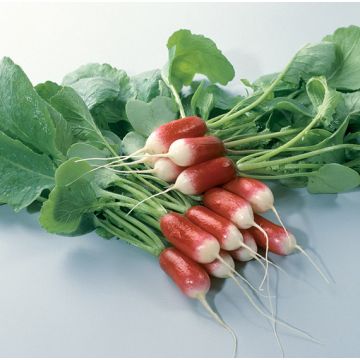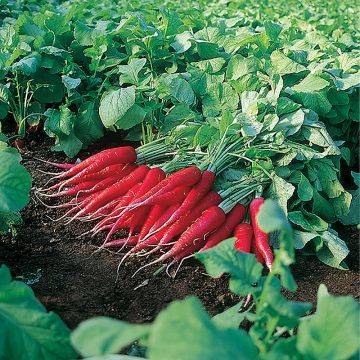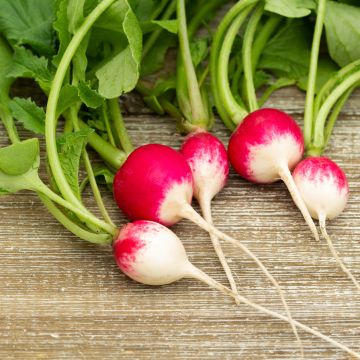

Giant Sicilian Radish NT - Ferme de Sainte Marthe seeds


Giant Sicilian Radish NT - Ferme de Sainte Marthe seeds
Giant Sicilian Radish NT - Ferme de Sainte Marthe seeds
Raphanus sativus Géant de Sicile
Radish, Garden Radish
Very pleased with this planting.
pascale, 17/04/2020
Special offer!
Receive a €20 voucher for any order over €90 (excluding delivery costs, credit notes, and plastic-free options)!
1- Add your favorite plants to your cart.
2- Once you have reached €90, confirm your order (you can even choose the delivery date!).
3- As soon as your order is shipped, you will receive an email containing your voucher code, valid for 3 months (90 days).
Your voucher is unique and can only be used once, for any order with a minimum value of €20, excluding delivery costs.
Can be combined with other current offers, non-divisible and non-refundable.
Why not try an alternative variety in stock?
View all →This plant carries a 6 months recovery warranty
More information
We guarantee the quality of our plants for a full growing cycle, and will replace at our expense any plant that fails to recover under normal climatic and planting conditions.
Description
'Giant of Sicily' radish is a late season variety, also known as 'Gigante Siculo'. It produces large, 4 to 5cm (2in) round radishes with bright red skin and firm, crunchy flesh. It is a good quality, tasty heirloom that is resistant to splitting. Sow the seeds from March to August. Harvest from April to September.
The radish is a fairly hardy annual or biennial vegetable plant, belonging to the Brassicaceae family. It is mainly grown for its root, which is eaten raw in salads. However, its freshly picked leaves can be used in soups or stews. Probably known since the Neolithic period, the radish is believed to originate from the Far East. The name "radish" comes from the Latin word "radix", which simply means a root. It was widely consumed by the ancient Egyptians, Romans, and in the Middle Ages, in forms probably different from what we know today. The red and white radishes arrived in the 18th century.
Radishes come in an array of shapes and sizes. Whilst most radishes are red or pink, some varieties have white, grey, or black skin. Radishes are generally grouped into two main categories: small-rooted varieties that can be grown most of the year such as round “Easter” radishes or elongated “French Breakfast” varieties; and large-rooted varieties, including Chinese white radish ('Daikon'), black radish, icicle radish and horseradish.
Winter radishes generally have a large taproot with black, pink, or purplish skin and white flesh. The leaves are green and indented, forming a compact clump at the base of the plant. Their taste is often stronger and spicier than smaller-rooted varieties. Winter radishes can be eaten cooked, like turnips, or raw, like carrots. They are very healthy, containing vitamin C, potassium, phosphorus, sulphur, and magnesium. They are known to help digestion and to detoxify the liver and stomach.
Harvesting and storage
Small-rooted varieties are ready to harvest 4 to 6 weeks after sowing. Pick them regularly, as soon as the roots are formed. When left to mature too long, radish roots become hollow and pithy. Fresh radishes are best eaten as soon as possible. The greens can be added to salads or soups.
Large-rooted varieties and winter varieties are harvested 4 to 5 months after sowing. Harvest the roots by gently lifting them with a garden fork. Leave them to dry on the ground before bringing them inside. When left in the ground over the winter months, protect the roots from frost damage by covering them with a layer of straw.
Good to know
Simultaneous sowing of radishes and carrots in the same row is a good way of naturally spacing out your carrot seeds. Once harvested, the radishes will leave room for the carrots to grow. For perfect, crisp radishes throughout the growing season, stagger your sowing (once every 2 to 3 weeks). Radishes are suitable for growing in pots and containers, with good soil and regular watering.
NB. Untreated seeds are produced from conventionally grown plants (that are often treated with phytosanitary products). However, they do not undergo any post-harvest treatment. These seeds are approved for organic market gardening when organic seeds are not available.
Report an error about the product description
Harvest
Plant habit
Foliage
Botanical data
Raphanus
sativus
Géant de Sicile
Brassicaceae
Radish, Garden Radish
Cultivar or hybrid
Biennial
Other Radish seeds
View all →Planting and care
Sowing
Small-rooted radishes are very easy to grow. Direct sow the seeds in rows or lightly scatter in well-loosened soil. Round radish seeds are covered with a very fine layer of soil. Elongated radish seeds are covered with 2cm (1in) of potting mix or fine soil. Firm down lightly with the back of a rake and water gently. Keep the soil moist until germination.
Radishes can be sown all year round, preferably from late winter to early summer (except during dry spells), and then in late summer/early autumn, when the soil is still warm and before the first frosts. Grow your radishes in open, sunny sites with light shade during the hot summer months. Water little but often.
Forcing varieties
Sow as early as February under a cold frame or tunnel until the risk of frost has passed. Early radish seeds can be lightly scattered rather than sown in rows.
Spring and summer radishes
Sow as regularly as needed from May until late summer, or even early autumn in warmer climates. Direct sow in rows, spaced 10 to 20cm (4 to 8in) apart.
Winter radishes
Direct sow from June to November depending on the climate, in rows spaced 20 to 30cm (8 to 12in) apart.
Care
Once the seedlings have emerged, they need to be thinned out. This consists of removing the weakest plants and keeping only the most vigorous (every 4 to 5cm (2in) for small-rooted radishes, and 10 to 15cm (4 to 6in) for large-rooted radishes).
The soil needs to be kept cool and moist by regular watering. Make sure to hoe, weed, and mulch your plants for milder, less fiery-tasting radishes. Moreover, constant soil moisture helps prevent flea beetles from damaging your crops as they thrive in hot, dry conditions.
Seedlings
Care
Intended location
-
, onOrder confirmed
Reply from on Promesse de fleurs
Similar products
Haven't found what you were looking for?
Hardiness is the lowest winter temperature a plant can endure without suffering serious damage or even dying. However, hardiness is affected by location (a sheltered area, such as a patio), protection (winter cover) and soil type (hardiness is improved by well-drained soil).

Photo Sharing Terms & Conditions
In order to encourage gardeners to interact and share their experiences, Promesse de fleurs offers various media enabling content to be uploaded onto its Site - in particular via the ‘Photo sharing’ module.
The User agrees to refrain from:
- Posting any content that is illegal, prejudicial, insulting, racist, inciteful to hatred, revisionist, contrary to public decency, that infringes on privacy or on the privacy rights of third parties, in particular the publicity rights of persons and goods, intellectual property rights, or the right to privacy.
- Submitting content on behalf of a third party;
- Impersonate the identity of a third party and/or publish any personal information about a third party;
In general, the User undertakes to refrain from any unethical behaviour.
All Content (in particular text, comments, files, images, photos, videos, creative works, etc.), which may be subject to property or intellectual property rights, image or other private rights, shall remain the property of the User, subject to the limited rights granted by the terms of the licence granted by Promesse de fleurs as stated below. Users are at liberty to publish or not to publish such Content on the Site, notably via the ‘Photo Sharing’ facility, and accept that this Content shall be made public and freely accessible, notably on the Internet.
Users further acknowledge, undertake to have ,and guarantee that they hold all necessary rights and permissions to publish such material on the Site, in particular with regard to the legislation in force pertaining to any privacy, property, intellectual property, image, or contractual rights, or rights of any other nature. By publishing such Content on the Site, Users acknowledge accepting full liability as publishers of the Content within the meaning of the law, and grant Promesse de fleurs, free of charge, an inclusive, worldwide licence for the said Content for the entire duration of its publication, including all reproduction, representation, up/downloading, displaying, performing, transmission, and storage rights.
Users also grant permission for their name to be linked to the Content and accept that this link may not always be made available.
By engaging in posting material, Users consent to their Content becoming automatically accessible on the Internet, in particular on other sites and/or blogs and/or web pages of the Promesse de fleurs site, including in particular social pages and the Promesse de fleurs catalogue.
Users may secure the removal of entrusted content free of charge by issuing a simple request via our contact form.
The flowering period indicated on our website applies to countries and regions located in USDA zone 8 (France, the United Kingdom, Ireland, the Netherlands, etc.)
It will vary according to where you live:
- In zones 9 to 10 (Italy, Spain, Greece, etc.), flowering will occur about 2 to 4 weeks earlier.
- In zones 6 to 7 (Germany, Poland, Slovenia, and lower mountainous regions), flowering will be delayed by 2 to 3 weeks.
- In zone 5 (Central Europe, Scandinavia), blooming will be delayed by 3 to 5 weeks.
In temperate climates, pruning of spring-flowering shrubs (forsythia, spireas, etc.) should be done just after flowering.
Pruning of summer-flowering shrubs (Indian Lilac, Perovskia, etc.) can be done in winter or spring.
In cold regions as well as with frost-sensitive plants, avoid pruning too early when severe frosts may still occur.
The planting period indicated on our website applies to countries and regions located in USDA zone 8 (France, United Kingdom, Ireland, Netherlands).
It will vary according to where you live:
- In Mediterranean zones (Marseille, Madrid, Milan, etc.), autumn and winter are the best planting periods.
- In continental zones (Strasbourg, Munich, Vienna, etc.), delay planting by 2 to 3 weeks in spring and bring it forward by 2 to 4 weeks in autumn.
- In mountainous regions (the Alps, Pyrenees, Carpathians, etc.), it is best to plant in late spring (May-June) or late summer (August-September).
The harvesting period indicated on our website applies to countries and regions in USDA zone 8 (France, England, Ireland, the Netherlands).
In colder areas (Scandinavia, Poland, Austria...) fruit and vegetable harvests are likely to be delayed by 3-4 weeks.
In warmer areas (Italy, Spain, Greece, etc.), harvesting will probably take place earlier, depending on weather conditions.
The sowing periods indicated on our website apply to countries and regions within USDA Zone 8 (France, UK, Ireland, Netherlands).
In colder areas (Scandinavia, Poland, Austria...), delay any outdoor sowing by 3-4 weeks, or sow under glass.
In warmer climes (Italy, Spain, Greece, etc.), bring outdoor sowing forward by a few weeks.



























































